
The Palazzo Pubblico is a palace in Siena, Tuscany, central Italy. Construction began in 1297 to serve as the seat of the Republic of Siena's government, which consisted of the Podestà and Council of Nine, the elected officials who performed executive functions.
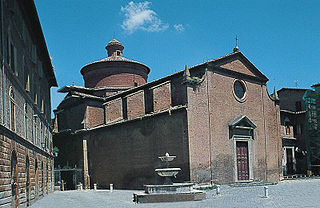
Santo Spirito is a Renaissance style, Roman Catholic church located in piazza Santo Spirito, where Via dei Pispini meets Vicolo del Sasso, in the city Siena, region of Tuscany, Italy.

The Basilica dell'Osservanza is a church on the outskirts of Siena, region of Tuscany, Italy.
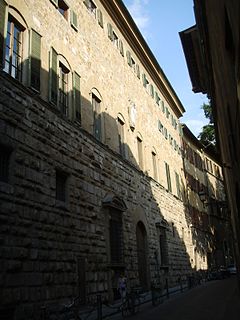
Palazzo Capponi alle Rovinate is a late-Gothic and early Renaissance-style residential palace located on Via de' Bardi in Florence, region of Tuscany, Italy. There are apparently three other palaces once associated with the Capponi family:

Palazzo Cocchi-Serristori is a Renaissance-style palace in Piazza Santa Croce, Florence, Italy. It presently houses offices of a regional council of Florence.

The Palazzo Bichi Ruspoli, or previously Palazzo or Castellare dei Rossi, is an urban palace, located on Via Banchi di Sopra in the present contrada of Civetta, Terzo di Camollia of the city of Siena, region of Tuscany, Italy.

San Giovannino della Staffa, also known as San Giovannino in Pantaneto is a Renaissance style, Roman Catholic church located on Piazetta Virgilio Grassi, in the Contrada del Leocorno, in the city of Siena, region of Tuscany, Italy.

The Palazzo Piccolomini, also known as the Palazzo Todeschini Piccolomini is a Renaissance-style palace in the city of Siena, region of Tuscany, Italy. It is located on the Banchi di Sotto, at the corner with Via Rinaldini; uphill and west of the church of San Martino, the Loggia del Papa, and the Palazzo delle Papesse, which also built by a Piccolomini family member.

The Palazzo Palmieri, or Palazzo Nuti, is a Mannerist style urban palace, located on Via del Moro #48 in the present contrada of Civetta, Terzo di Camollia of the city of Siena, region of Tuscany, Italy.
Sant’Andrea Apostolo is a Roman Catholic church located on Via dei Montanini 141, near the intersection with Via Giuseppe Garibaldi, in the terzo of Camollia, in the city of Siena, region of Tuscany, Italy.

San Niccolò al Carmine, also called Santa Maria del Carmine is a Renaissance style, Roman Catholic church and monastery located in Pian dei Mantellini #30, near the corner of Via della Diana in the Terzo de Citta of Siena, region of Tuscany, Italy. The church now serves as the Oratory for the Contrada of Pantera. Across the street from the belltower is the Palazzo Celsi Pollini. North along Pian dei Mantellini, toward the Arco delle Due Porte, and on the same side of the street are a number of palaces built around what was once the Monastery of the Derelict Women: in order they are the Neoclassical Palazzo Incontri, the Palazzo Ravissa and the Palazzo Segardi.
The Castello di Belcaro is a Renaissance villa built at the site of a Castle once belonging to the Republic of Siena in Tuscany. It is located some 5.5 kilometers southwest of the Siena city gate of Porta San Marco, on the direction towards Grosseto, it is beyond a former benedictine monastery and church of Sant'Eugenio. The address is strada di Terrenzano e Belcaro #32.
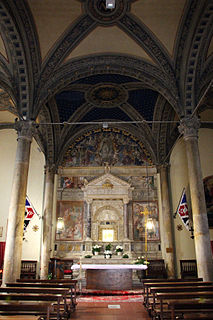
Santa Maria in Portico a Fontegiusta is a Renaissance style, Roman Catholic church located on via di Fontegiusta, off Via Camollia near its intersection with Via Paparoni, in the terzo of Camollia, in Siena, region of Tuscany, Italy.
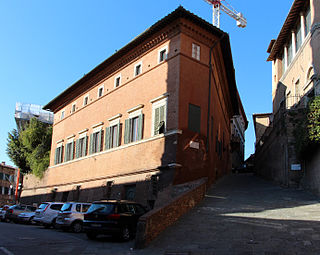
The Palazzo Celsi Pollini, once also called the Palazzo del Vescovo, is a Renaissance style urban palace in Siena, Italy. It is located on Pian dei Mantellini #39-41, at the corner with Via San Quirico. A 19th-century source refers to the house as Casa Campioni. The main facade faces the campanile of San Niccolò del Carmine.
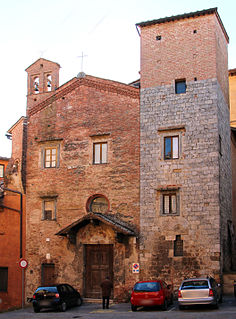
The Church of the Jail of Sant'Ansano, Italian: Chiese delle Carceri di Sant'Ansano, also known as the Chapel or Oratory of Sant'Ansano in Castelvecchio, is a small, medieval, Roman Catholic religious building located on via Tommaso Pendola in the Terzo di Città of the city of Siena, region of Tuscany, Italy. Adjacent to the tower is the former Istituto Santa Teresa.
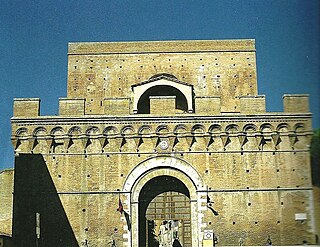
The Porta dei Pìspini or Gate of the Water-spout is one of the portals in the medieval walls of Siena, region of Tuscany, Italy. It is located on the east side of town, in the contrada del Nicchio in the terzo of San Martino, where Via Pìspini meets Via Aretina. The gate took its name from a nearby fountain; the nearby Fonte de' Pispina, however, was built in 1534–1538.

The Villa Santa Colomba is a renaissance-style fortress palace structure located in the village of Santa Colomba, a frazione of Monteriggioni, a few miles outside Siena, in the region of Tuscany, Italy.
The Monastery of San Girolamo in Campansi is a former convent located on Via Campansi #18 in the city of Siena, region of Tuscany, Italy. The Baroque-style church still stands as an independent chapel; while the monastery has been converted to a nursing home for the elderly. There is a separate Monastery of San Girolamo on via San Girolamo, located in a different contrada of Siena.
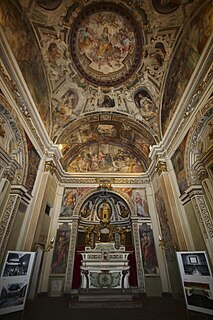
Santa Marta is a former Roman Catholic convent and church of located in the city of Siena, region of Tuscany, Italy. It now serves in part as historic archive for Siena. It is located about 30 meters downhill of the Cappella del Rosario on Via San Marco and 30 meters uphill of Porta San Marco.

The Palazzo Piccolomini-Clementini is a Gothic-style palace located on Via Banchi di Sotto #75 in the city of Siena, region of Tuscany, Italy. It is located across the street from the more imposing Renaissance-style Palazzo Piccolomini and the Loggia del Papa. The nearby Palazzo delle Papesse was also built by a Piccolomini family member.






















